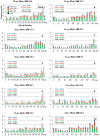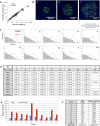Quantitative analysis of intra- and inter-individual variability of human beta-cell mass
- PMID: 29180621
- PMCID: PMC5703964
- DOI: 10.1038/s41598-017-16300-w
Quantitative analysis of intra- and inter-individual variability of human beta-cell mass
Abstract
Pancreatic beta-cell mass is a critical determinant of the progression of diabetes. The loss of beta-cells in various types of diabetes has been documented in comparison to age, sex and body mass index (BMI) matched control subjects. However, the underlying heterogeneity of beta-cell mass in healthy individuals has not been considered. In this study, the inter-individual heterogeneity in beta-cell/islet mass was examined among 10 cases of age-matched non-diabetic male subjects in relation to BMI, pancreas weight, and the percent ratio, volume and number of islets in the whole pancreas. Beta-cell/islet mass was measured using a large-scale unbiased quantification method. In contrast to previous studies, we found no clinically relevant correlation between beta-cell/islet mass and age, BMI or pancreas weight, with large differences in beta-cell/islet mass and islet number among the individuals. Our method extracts the comprehensive information out of individual pancreas providing multifaceted parameters to study the intrinsic heterogeneity of the human pancreas.
Conflict of interest statement
The authors declare that they have no competing interests.
Figures




References
Publication types
MeSH terms
Grants and funding
LinkOut - more resources
Full Text Sources
Other Literature Sources

